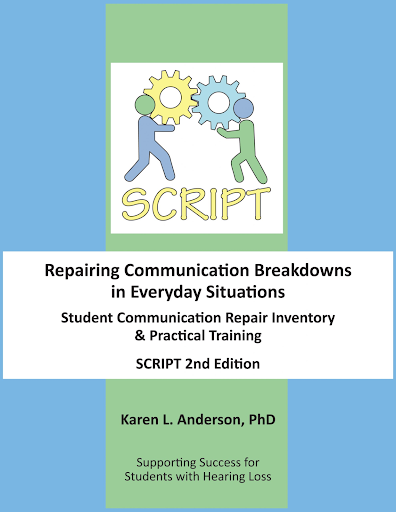Related Products
For Professionals
- Amplification
- Assessment of Student Skills, Challenges, Needs
- Early Childhood: Infants, Toddlers, Preschool
- Hearing Loss – Identification, Impact and Next Steps
- IDEA Law Summary Information
- Language and Speech Development Issues
- Legal Issues in Serving Children with Hearing Loss
- Listening (Auditory Skills) Development
- Planning to Meet Student Needs
- Self-Advocacy Skills for Students with Hearing Loss
- Self-Concept: How the Child with Hearing Loss Sees Himself
- Social Skills
- Speech Perception & Learning
Related Teacher Tools Takeout Items
Self-Advocacy for Students with Hearing Loss: A Resource Guide

What’s the Point?
Students with hearing loss often encounter barriers the classroom:
- such as difficulty understanding lectures,
- participating in group discussions, or
- accessing auditory information
Effective self-advocacy ensures:
- Equal Access-Students receive accommodations that support their learning.
- Independence-Self-advocacy helps students take control of their education.
- Confidence-Speaking up about one’s needs can build self-confidence and resilience.
- Collaboration-It fosters better communication between students, teachers, and peers.
Teachers of the Deaf and Hard of Hearing MUST teach Key Self-Advocacy Skills for Students with Hearing Loss.
Teach them how to Understand their Hearing Loss (PA-ECC for DHH )
Depending on the child’s age, teach age appropriate skills that the child will understand about their hearing loss. Skills such as these below are only a few things that a student should know:
- Know the type and degree of your hearing loss, and how it affects your ability to communicate and learn.
- Be familiar with assistive technology (hearing aids, cochlear implants, FM systems) and accommodations that work best for you. https://www.cochlear.com/us/en/home
- Recognize their “better” ear and sit with that ear towards the speaker.
Know Your Rights!!
Familiarize yourself with laws that protect students with disabilities, such as the Individuals with Disabilities Education Act (IDEA), Section 504 of the Rehabilitation Act, and the Americans with Disabilities Act (ADA).
Ensure that your school has a 504 Plan or Individualized Education Program (IEP) that outlines necessary accommodations.
Check This Out: https://www.imdetermined.org/tool/transition-guide-postsecondary-education-training/
Practice Effective Communication
Develop clear, assertive communication strategies to express your needs to teachers and classmates.
For example:
– “I need to sit in the front to better understand the lecture.”
– “Could you please repeat that or speak more clearly?”
– “I rely on captions, so please ensure videos are captioned.”
– Make sure to advocate for appropriate communication methods, whether it’s written instructions, visual aids, or the use of technology like captioning or real-time transcription services (CART).
Strategies for Effective Communication
- Always face the student whom you are addressing;
- Make sure you have the student’s attention before you start speaking;
- Do not speak too loudly or exaggerate lip movements for the student who is lip-reading;
- Repeat or rephrase the message if the student seems confused;
- Write down the message you are trying to communicate;
- Act out the message or use visual cues or symbols;
- Do not become frustrated, aggravated, or say “never mind” when communication is difficult;
- Look for activities where less talk is required, such as sports, computers, puzzles, or board games.
Be Proactive
Speak with teachers and support staff early in the semester about your hearing loss and any accommodations you need. This could include:
– Preferential seating.
– Use of FM systems.
– Note-taking services.
– Access to lecture materials ahead of time.
– Join school clubs or extracurricular activities that foster inclusion and communication, so that you feel comfortable engaging with peers.
Utilize Assistive Technologies
– Take advantage of technologies designed to assist students with hearing loss, such as:
– FM systems.
– Captioned media.
– Amplified phones or captioning apps.
– Speech-to-text software or real-time transcription services.
– Know how to troubleshoot your devices and ask for help when needed.
Build a Support Network
– Seek support from peers, family members, and professionals. Your support system can help you practice self-advocacy and provide emotional backing when facing challenges.
– Work with your school’s disability services or counseling office to ensure consistent access to the accommodations you need.
– Connect with other students who have hearing loss through online communities or support groups.
Evaluate and Adjust
– Regularly assess the effectiveness of your accommodations and communication strategies. If something isn’t working, be prepared to modify your approach.
– Request adjustments as needed, whether it’s a new seating arrangement, different technology, or additional support.
Check out these resources for help advocate!
- https://teachertoolstakeout.com/0363-topical-articles
- https://teachertoolstakeout.com/0584-checklists
- https://teachertoolstakeout.com/0597-checklists
- https://teachertoolstakeout.com/0111-checklists
- https://teachertoolstakeout.com/0325-checklists
- https://successforkidswithhearingloss.com/wp-content/uploads/2011/12/Necessary-Supports-Worksheet-EXAMPLE.pdf
- https://successforkidswithhearingloss.com/wp-content/uploads/2017/06/Supporting-Self-Advocacy-Skills-M-J-2018-FOCUS-Newsletter_euse.pdf
- https://successforkidswithhearingloss.com/product/building-skills-for-independence-in-the-mainstream/
Resources for Students with Hearing Loss
National Association of the Deaf (NAD)
[www.nad.org](https://www.nad.org)
Offers advocacy, legal resources, and information on educational rights.
Hearing Loss Association of America (HLAA)
[www.hearingloss.org](https://www.hearingloss.org)
Provides support and resources for people with hearing loss, including educational tools.
Hands & Voices
[www.handsandvoices.org](https://www.handsandvoices.org)
Offers parent-driven support and resources for families and professionals working with children with hearing loss.
